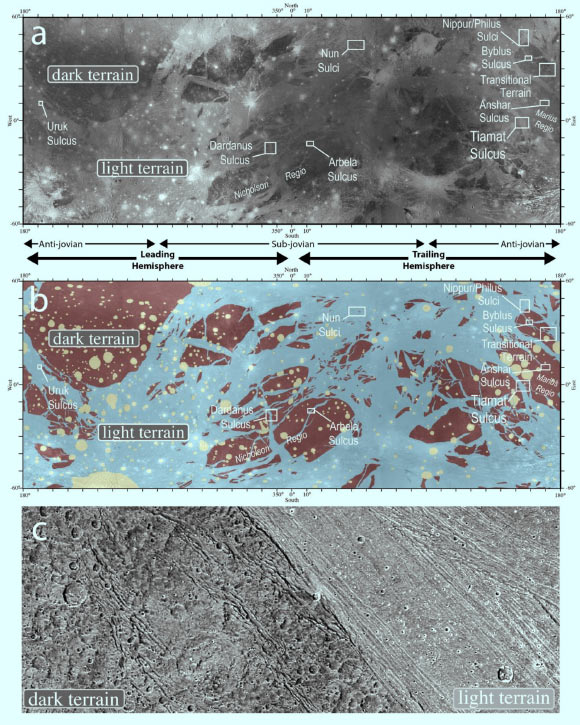A new study, published in the journal Icarus, reveals Ganymede — the largest and most massive moon of Jupiter and in the Solar System — appears to have undergone complex periods of geologic activity, specifically strike-slip tectonism, as is seen in the San Andreas Fault on Earth.

Ganymede, larger than even Mercury and Pluto, has an icy surface speckled with bright young craters overlying a mixture of older, darker, more cratered terrain laced with grooves and ridges; the large circular feature on the upper right, called Galileo Regio, is an ancient region of unknown origin; Ganymede is thought to have an ocean layer that contains more water than Earth and might contain life; like Earth’s Moon, Ganymede keeps the same face towards its central planet, in this case Jupiter; this image was taken about 20 years ago by NASA’s Galileo probe, which ended its mission by diving into Jupiter’s atmosphere in 2003; currently, NASA’s Juno spacecraft orbits Jupiter and is studying the giant planet’s internal structure, among many other attributes. Image credit: NASA / JPL / Galileo probe.
Ganymede and Europa, another of Jupiter’s moons, are believed to be ocean worlds, that is they have a liquid water ocean lying beneath an ice shell.
Europa is thought to be the most likely place in the Solar System to find life today, presumably in the ocean where it may be protected from extreme radiation by the ice shell.
Planetary researchers know that Europa has tectonic processes similar to Earth’s.
However, while Ganymede was once tectonically active, it is no longer — which offers researchers a chance to look into Europa’s future.
“The heavily fractured surface of Ganymede displays many distinctive regions of inferred strike-slip faulting that may be important to the structural development of its surface,” said study lead author Dr. Marissa Cameron, a researcher in the Department of Geology and Geophysics at the University of Hawai’i at Manoa.

Ganymede map and terrain types: (a) Ganymede global mosaic; examples of dark and light terrain are labeled; labeled boxes denote sites mapped in this study; (b) Ganymede global geologic map overlaying the global image mosaic; the domains are divided into: dark terrain (brown), light terrain (blue), and impact features (yellow); (c) representative example of dark terrain of Nicholson Region (left) at the boundary of light (grooved) terrain (right) of Harpag ia Sulcus. Image credit: NASA / Cameron et al, doi: 10.1016/j.icarus.2018.06.024.
To better understand the role of strike-slip tectonism in shaping Ganymede’s complex icy surface, Dr. Cameron and co-authors performed detailed mapping of nine locations using imagery collected by NASA’s Galileo and Voyager probes.
The team mapped nine sites of both light, grooved terrain (Nun Sulci, Dardanus Sulcus, Tiamat Sulcus, Uruk Sulcus, and Arbela Sulcus) and terrains that are transitional from dark to light terrains (Nippur and Philus Sulci, Byblus Sulcus, Anshar Sulcus, and the Transitional Terrain of Northern Marius Regio).
“The unexpected finding was how commonplace strike-slip faulting was,” Dr. Cameron said.
“Indicators of strike-slip were observed at all nine sites, representing various geographic locations on Ganymede.”
“Additionally, the similarities between the sites may be indicative of a past, larger scale process.”
“Incorporating our observations with previous studies provides an improved representation of Ganymede’s tectonic history and allows us to learn more about its neighbor, Europa.”
_____
Marissa E. Cameron et al. 2018. Morphological mapping of Ganymede: Investigating the role of strike-slip tectonics in the evolution of terrain types. Icarus 315: 92-114; doi: 10.1016/j.icarus.2018.06.024







